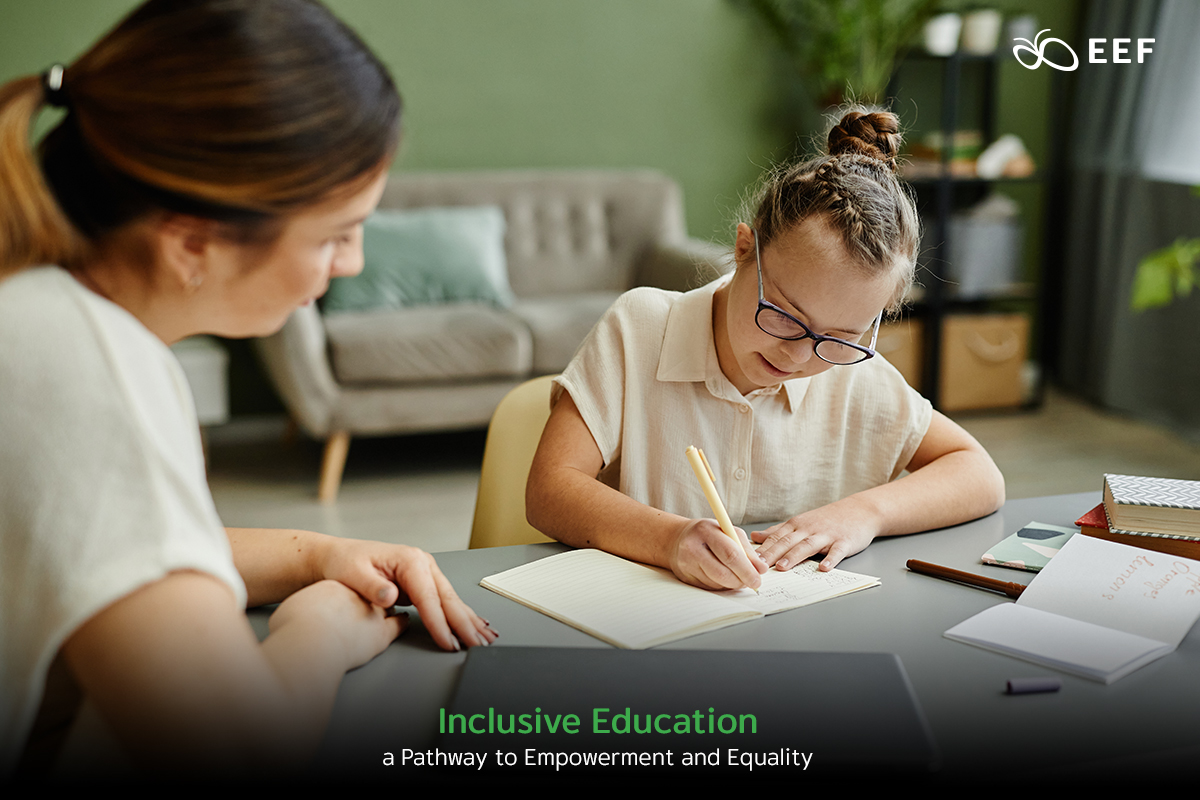
Globally, there are approximately 240 million children with disabilities, each with their aspirations and dreams for the future. However, these children often face significant obstacles in accessing quality education and fully participating in society. Regrettably, children with disabilities are frequently overlooked in policymaking, resulting in limited educational opportunities and exclusion from social, economic, and political spheres. Alarmingly, they are among the most marginalized groups when it comes to school attendance. Discrimination, stigma, and decision-makers failure to prioritize disability in educational services contribute to persistent barriers.

Disability stands as a formidable impediment to education worldwide, depriving these children of their fundamental right to learn. Consequently, they are denied the opportunity to actively engage in their communities, join the workforce, and influence decisions that profoundly impact their lives. Much needed is a school where every student, regardless of their challenges, is welcomed into age-appropriate general education classes within their local community, to receive high-quality instructions, interventions, and support that enable them to meet success in the core curriculum.
This is the essence of inclusive education, a powerful approach that believes in the fundamental competence of students with disabilities. In an inclusive classroom, barriers crumble as all students are allowed to fully participate, learn, and grow together. By embracing and addressing the diverse needs of students, be it physical, cognitive, academic, social, or emotional, we create an environment where everyone feels valued, supported, and appropriately challenged.
Inclusive Education Principles and Benefit
Inclusive education is founded on the belief that students with disabilities possess the same fundamental competence as their peers without disabilities. This principle drives schools and classrooms to create an environment where all students can actively participate academically and socially. Central to inclusive education is the concept of the Least Restrictive Environment (LRE), which guides the placement of students with disabilities alongside their peers in general education settings to the maximum extent possible. By prioritizing equal opportunities for all students to thrive, inclusive education promotes a cohesive, seamless, and supportive learning environment.
The growing momentum behind inclusive education and inclusive classrooms is fueled by a substantial body of research-based evidence that highlights the multitude of benefits associated with these approaches. Over the past three decades, consistent studies have shown that both students with disabilities and their peers without disabilities experience improved learning outcomes in inclusive environments.

Students with disabilities demonstrate enhanced academic achievements, particularly in areas, such as literacy, math, and social studies, both in terms of grades and standardized test scores. Additionally, they develop improved communication and social skills, leading to stronger self-concepts and increased friendships. Likewise, students without disabilities exhibit more positive attitudes, achieve greater academic progress in subjects like literacy and math, and benefit from expanded learning opportunities provided by teachers through a variety of modalities, such as serving as peer coaches.
Contrary to concerns, research indicates that there are no significant differences in instructional time or student engagement between inclusive and non-inclusive classrooms. Students without disabilities often remain unaware of the presence of their peers with disabilities in their classes, and when they do become aware, they tend to exhibit higher levels of acceptance and tolerance, fostering a sense of inclusivity within the educational setting.
Furthermore, parents of students with disabilities generally develop more positive attitudes toward inclusion as they gain more experience with inclusive education. Meanwhile, parents of students without disabilities consistently hold favorable views on inclusive education. The evidence strongly supports the effectiveness and acceptance of inclusive education, providing a compelling rationale for its widespread implementation.

Inclusive Education Strategy
Comprehensive support for teachers is vital in implementing inclusive classroom strategies, considering that initial attitudes toward inclusive education tend to be neutral or negative due to a perceived lack of knowledge, competence, and confidence in teaching students with disabilities. However, as teachers gain experience and undergo training in inclusive education, their attitudes become more positive. Formal training plays a crucial role in long-term success. Effective inclusive classroom strategies revolve around understanding best practices in teaching, delivering adapted instruction for students with disabilities, and fostering positive attitudes toward inclusion.
Effective Strategies for Inclusive Classrooms:
- Utilize Various Instructional Formats:
- Establish a foundation through whole-group instruction, supported by interactive whiteboards and technology to enhance engagement;
- Transition to flexible groupings, such as small groups, stations/centers, and paired learning, with teacher-led guidance for younger students and student-led initiatives for older students while teachers monitor their progress.
- Ensure Equitable Access to Academic Curricular Content:
- Deliver clear instructions to ensure understanding for all students;
- Foster active participation and encourage students to initiate activities;
- Promote inclusive large group instruction, fostering a sense of belonging for all students;
- Coordinate transitions to maintain a cohesive classroom environment and keep students on track with the lessons.
- Apply Universal Design for Learning:
- Employ diverse methods to present content and assess learning, utilizing techniques like modeling, images, manipulatives, and graphic organizers;
- Customize adaptations for students with disabilities, such as providing large print materials, headphones, peer support, visual aids, calculators, and extra time for completing tasks.
- Foster Peer-Supported Learning:
- Encourage collaborative pair-work and cooperative grouping to foster teamwork and mutual learning;
- Facilitate peer tutoring to enhance understanding and engagement among students;
- Empower students to take the lead in demonstrations, sharing their knowledge and skills with their peers.
- Cultivate Project-Based and Inquiry Learning:
- Promote independent and collective exploration of real-life experiences, encouraging students to investigate and analyze;
- Nurture active learning and critical thinking skills development through hands-on projects and inquiry-based approaches.
Inclusive education serves as the cornerstone for equitable access to education, providing all children with equal opportunities to acquire knowledge and skills essential for their overall development and achievement. It embraces the integration of children with disabilities and diverse challenges into mainstream classrooms, fostering authentic learning experiences for historically marginalized groups. By acknowledging and appreciating the unique contributions of students from various backgrounds, inclusive education enriches their educational journeys and benefits the entire learning community. It not only cultivates an inclusive and accepting learning environment but also promotes the holistic growth of students. Achieving inclusive education necessitates comprehensive and systemic transformations across multiple societal levels.

3 Key Steps for the Success of Inclusive Education:
- Data Collection and Analysis:
- Regularly collect and analyze data.
- Identify gaps and measure progress.
- Ensure effective services reach every child.
- School Level:
- Provide teachers with the necessary training to support diverse learners.
- Adapt school infrastructure for accessibility.
- Prioritize the availability of appropriate learning materials.
- Community Level:
- Address stigma and discrimination.
- Educate communities about the benefits of inclusive education.
- Foster inclusive mindsets.
- Government Level:
- Drive policies regarding inclusive education forward.
- Align laws and policies with the Convention on the Rights of Persons with Disabilities (CRPD).
- Protect and promote the rights of all children.
Although progress towards inclusive education may be gradual, it is a cause worth pursuing with unwavering determination. By dismantling barriers and promoting inclusive practices, we can create an education system that celebrates diversity, empowers all learners, and contributes to a more inclusive and equitable society. Together, let us strive for a future where every child has the opportunity to thrive and reach their full potential through inclusive education. To promote inclusive education, the focus must be made on four key areas: advocacy, awareness-raising, capacity-building, and implementation support.

4 Key Areas for Promoting Inclusive Education:
- Advocacy:
-
- Promote inclusive education through discussions and events.
- Engage policymakers and the general public in advocating for inclusive education.
- Awareness-Raising:
-
- Research to highlight the needs of children with disabilities.
- Host roundtables, workshops, and events to raise awareness.
- Collaborate with government partners to address these needs.
- Capacity-Building:
-
- Strengthen education systems through training.
- Empower teachers, administrators, and communities to support inclusive education.
- Provide technical assistance to governments.
- Implementation support:
-
- Assist partner countries in monitoring and evaluating progress.
- Bridge the gap between policy and practice.
- Ensure effective implementation of inclusive education.
The future outlook for inclusive education is auspicious. Mounting evidence demonstrates that inclusive classrooms not only fulfill the needs of students with disabilities according to the Least Restrictive Environment (LRE) principle but also bring benefits to regular education students. As parents and teachers gain exposure to inclusive education, their attitudes become more positive. With proper training and support, regular education teachers can confidently and successfully implement inclusive education practices. Ultimately, inclusive education proves to be a mutually beneficial approach for all stakeholders involved, resulting in a positive outcome for everyone.

Inclusive education is a powerful force that transforms the lives of children with disabilities and creates enriched learning environments for all students. By breaking down barriers, fostering positive attitudes, and implementing effective strategies, we can create classrooms where every student thrives. The evidence is clear: inclusive education leads to improved academic outcomes, social growth, and acceptance among peers. As we embrace the principles of inclusivity and work together to advocate, raise awareness, build capacity, and provide implementation support, we pave the way for a brighter, more equitable future where every child has the opportunity to shine and contribute their unique gifts to the world. Together, we unlock the potential within every student through the power of inclusive education.
In its commitment to inclusive education, the Equitable Education Fund (EEF) Thailand plays a crucial role in advancing the cause. Through its initiatives, the EEF strives to dismantle barriers and promote equitable access to quality education for all children, including those with disabilities. By providing support, resources, and capacity-building opportunities to schools and educators, the EEF empowers them to create inclusive learning environments where every student can thrive. Through its advocacy, awareness-raising, and implementation support, the EEF contributes to the transformation of education in Thailand, ensuring that no child is left behind on their educational journey.
Source:
- Resilient Educator. Inclusive Education: What It Means, Proven Strategies, and a Case Study By Lilla Dale McManis, Ph.D. https://resilienteducator.com/classroom-resources/inclusive-education/
- Inclusive education: Every child has the right to quality education and learning. UNICEF. https://www.unicef.org/education/inclusive-education

